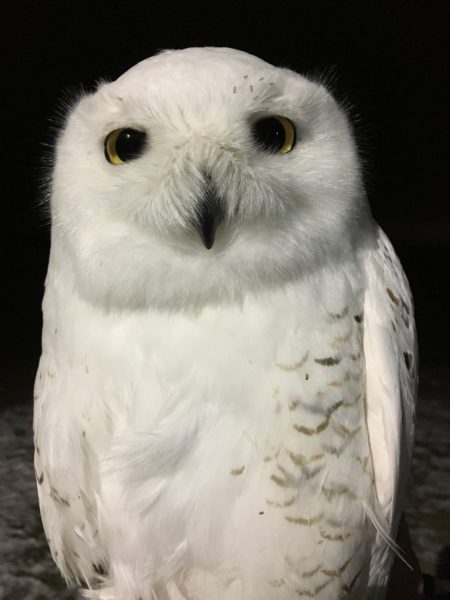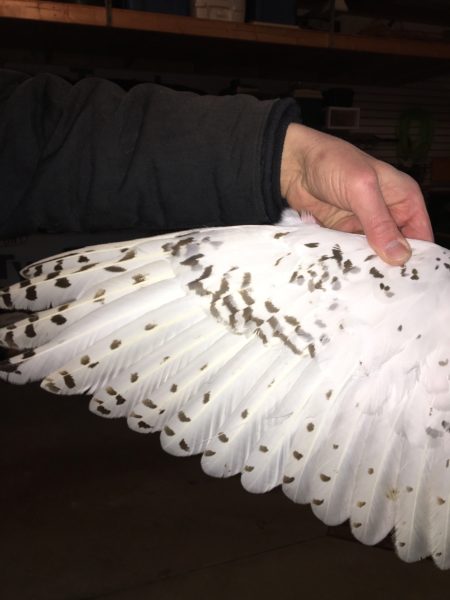
Harwood, an adult male tagged in eastern North Dakota north of Fargo. (©Matt Solensky)
We have a new tagged owl on the prairies of eastern North Dakota — and if you’re driving on Interstate 29 north of Fargo, keep an eye out for him, because he likes billboards.
Wildlife biologist Matt Solensky usually works the land west of Jamestown, ND, where he’s tagged several owls for Project SNOWstorm over the past few years. This year snowies have been scarce in that area, though, so this month — with the help of several birders in Fargo — he shifted his attention farther east. The birders had located up to five snowies in the Fargo area, so last weekend Matt tried to work two different birds. The results were less than ideal. After waiting for more than two hours to see if the first owl would make a run on his trap, Matt inadvertently flushed it while trying to move the lure closer.
At that point, without a lot of daylight left, Matt shifted his attention to the second snowy, a few miles down the road. “This bird sat for an hour and a half before it made one attempt at the BC [bal-chatri trap] and didn’t get caught. It went back to its stack of large hay bales and perched until it was too dark for me to see,” Matt said.

The mix of old and fresh flight feathers shows that Harwood is an adult. (©Matt Solensky)
The next day, neither of the previous day’s owls were around, so Matt decided to try for a snowy owl that had been seen on a billboard along I-29. The only access was a frontage road, where Matt was concerned that the trap would be too far from the owl to generate a response. Not to worry. “I put the BC on the opposite side of my truck from where he was, and as I started to drive away he was already up and heading toward the trap. I had trouble driving and watching through my mirrors, but I don’t think he hit the trap.” (A bal-chatri, you may recall, is a cage with large, monofilament nooses that catch the owl’s foot when it tries to reach the lure — in this case a couple of pigeons — inside.)
“I decided to set out another BC with only one pigeon. Almost immediately he went after it and on his second pass got caught by the absolute lowest number of nooses possible — one,” Matt said. The owl proved to be an adult male that weighed a very healthy 1,735 grams (about 3.8 pounds). Matt nicknamed him Harwood for a nearby town — and his tracking data since his release shows Harwood’s been back on that billboard along the interstate. His map will be up shortly — in the meantime, wave howdy when you go by.


9 Comments on “Harwood, the Roadside Owl”
Is Harwood really a male ? Or is it because he is young that the feathers are not all white ?
Plumage coloration on snowy owls varies a great deal from individual to individual, and is far less cut-and-dried than a lot of birders assume. While juveniles average darker than adults, and females average more heavily marked than males, there’s a lot of variation and overlap. Some of our Canadian colleagues, for example, have shown that some individual snowies will get lighter for several years and then reverse course to become darker, or vice versa. Harwood is only in his second winter, so even if he’s one of the males that eventually becomes largely white, he still has some time. Many of his flight feathers, for example, are retained juvenile feathers from his first summer.
I should also have mentioned that when we sex an owl in the hand, we’re relying not just on plumage characteristics, but also body mass and wing chord length, since females average about a third larger than males.
Am I the only one who finds bal-chatri traps to be well, rather crude and potentially damaging to a bird?
We appreciate Peter’s comment and concern. Bal-chatris have a long history in raptor research (and even even longer one in falconry — they were first used in India millennia ago, made of woven basketry cages and horsehair nooses, to catch small hawks). The ones we use are lightweight, connected via a bungee cord to a drag weight that is just heavy enough that the owl can’t fly off with it. The biggest issue with using a BC on owls, especially snowies, is that their heavily feathered legs and toes slip the mono noose rather easily, compared with hawks or falcons that have bare tarsi.
I have the utmost confidence that the folks at projectsnowstorm are professionals, and that they have each owl’s safety as their first priority during any interaction. They make a huge commitment of hours, resources and sheer effort – all for love of the owls! I’m pretty sure they know their owls and use the safest and most efficacious methods to capture and radio tag them! Thank you for sharing your progress with all of us projectsnowstorm!
It’s been a quieter season for snowy owls in New England this year than the last few including a very good year last year.
Awhile back I was given the following information regarding the gender of juveniles.
The tail on a juvenile in flight is a good indicator of sex.
4 or more bars that run all the way to the outer tail feathers and you have a female.
1 or two bars that do not make it to the outer tail feathers, with some random marks above, and you have a male.
Is this accurate?
Thanks for all you do to protect and research the behavior of these magnificent creatures.
Howard Muscott
http://www.chasingthegoldenlight.com
It’s not quite that clearcut and definitive, but there is some correlation with tail pattern and sex. *Most of the time,* a male will have three tail bars or fewer, and the bars generally do not extend all the way to the edge of the feather. Females generally have three bars or more, and they usually extend to the feather edge. But as you can see, there are areas of overlap. The most definitive way to sex snowies by plumage is by looking at the middle secondaries in the wing, and only in juveniles or those retaining juvenile middle secondaries. In these birds, females will have bars that touch the quill, whilew males have spots that do not touch the quill. (The wing-pattern technique is from a paper published by Seidensticker et al. in 2011 in the Journal of Raptor Research, and based in Denver Holt’s team’s work in Alaska.)
Thanks for the information Scott!